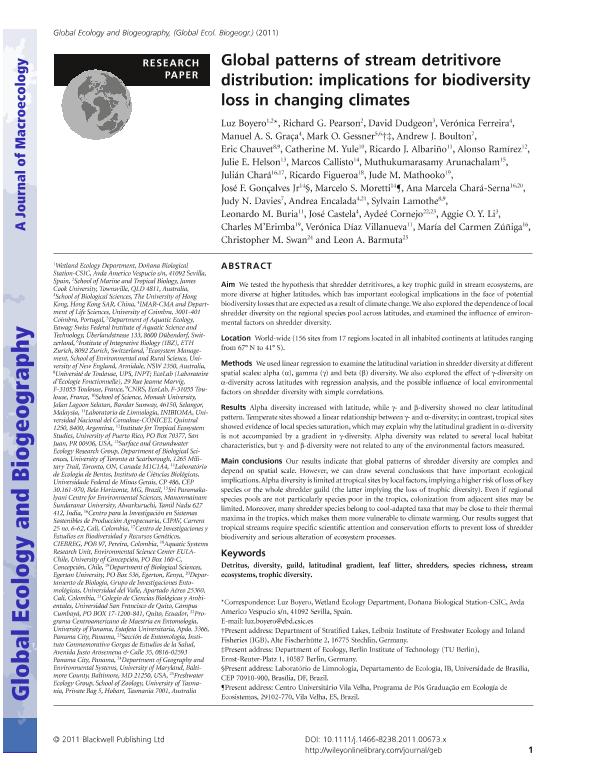Artículo
Global patterns of stream detritivore distribution: Implications for biodiversity loss in changing climates
Boyero, Luz; Pearson, Richard G.; Dudgeon, David; Ferreira, Verónica; Graca, Manuel A. S.; Gessner, Mark O.; Boulton, Andrew J.; Chauvet, Eric; Yule, Catherine M.; Albariño, Ricardo Javier ; Ramírez, Alonso; Helson, Julie E.; Callisto, Marcos; Arunachalam, Muthukumarasamy; Chará, Julián; Figueroa, Ricardo; Mathooko, Jude M.; Goncalves Jr, José F.; Moretti, Marcelo S.; Chará Serna, Ana Marcela; Davies, Judy N.; Encalada, Andrea C.; Lamothe, Sylvain; Buria, Leonardo Mario
; Ramírez, Alonso; Helson, Julie E.; Callisto, Marcos; Arunachalam, Muthukumarasamy; Chará, Julián; Figueroa, Ricardo; Mathooko, Jude M.; Goncalves Jr, José F.; Moretti, Marcelo S.; Chará Serna, Ana Marcela; Davies, Judy N.; Encalada, Andrea C.; Lamothe, Sylvain; Buria, Leonardo Mario ; Castela, José; Cornejo, Aydeé; Li, Aggie O. Y.; M´Erimba, Charles; Diaz Villanueva, Veronica
; Castela, José; Cornejo, Aydeé; Li, Aggie O. Y.; M´Erimba, Charles; Diaz Villanueva, Veronica ; Zúñiga, María del Carmen; Swan, Christopher M.; Barmuta, León A.
; Zúñiga, María del Carmen; Swan, Christopher M.; Barmuta, León A.
 ; Ramírez, Alonso; Helson, Julie E.; Callisto, Marcos; Arunachalam, Muthukumarasamy; Chará, Julián; Figueroa, Ricardo; Mathooko, Jude M.; Goncalves Jr, José F.; Moretti, Marcelo S.; Chará Serna, Ana Marcela; Davies, Judy N.; Encalada, Andrea C.; Lamothe, Sylvain; Buria, Leonardo Mario
; Ramírez, Alonso; Helson, Julie E.; Callisto, Marcos; Arunachalam, Muthukumarasamy; Chará, Julián; Figueroa, Ricardo; Mathooko, Jude M.; Goncalves Jr, José F.; Moretti, Marcelo S.; Chará Serna, Ana Marcela; Davies, Judy N.; Encalada, Andrea C.; Lamothe, Sylvain; Buria, Leonardo Mario ; Castela, José; Cornejo, Aydeé; Li, Aggie O. Y.; M´Erimba, Charles; Diaz Villanueva, Veronica
; Castela, José; Cornejo, Aydeé; Li, Aggie O. Y.; M´Erimba, Charles; Diaz Villanueva, Veronica ; Zúñiga, María del Carmen; Swan, Christopher M.; Barmuta, León A.
; Zúñiga, María del Carmen; Swan, Christopher M.; Barmuta, León A.
Fecha de publicación:
02/2012
Editorial:
Wiley Blackwell Publishing, Inc
Revista:
Global Ecology and Biogeography
ISSN:
1466-822X
e-ISSN:
1466-8238
Idioma:
Inglés
Tipo de recurso:
Artículo publicado
Clasificación temática:
Resumen
Aim: We tested the hypothesis that shredder detritivores, a key trophic guild in stream ecosystems, are more diverse at higher latitudes, which has important ecological implications in the face of potential biodiversity losses that are expected as a result of climate change. We also explored the dependence of local shredder diversity on the regional species pool across latitudes, and examined the influence of environmental factors on shredder diversity. Location: World‐wide (156 sites from 17 regions located in all inhabited continents at latitudes ranging from 67° N to 41° S). Methods: We used linear regression to examine the latitudinal variation in shredder diversity at different spatial scales: alpha (α), gamma (γ) and beta (β) diversity. We also explored the effect of γ‐diversity on α‐diversity across latitudes with regression analysis, and the possible influence of local environmental factors on shredder diversity with simple correlations. Results: Alpha diversity increased with latitude, while γ‐ and β‐diversity showed no clear latitudinal pattern. Temperate sites showed a linear relationship between γ‐ and α‐diversity; in contrast, tropical sites showed evidence of local species saturation, which may explain why the latitudinal gradient in α‐diversity is not accompanied by a gradient in γ‐diversity. Alpha diversity was related to several local habitat characteristics, but γ‐ and β‐diversity were not related to any of the environmental factors measured. Main: conclusions Our results indicate that global patterns of shredder diversity are complex and depend on spatial scale. However, we can draw several conclusions that have important ecological implications. Alpha diversity is limited at tropical sites by local factors, implying a higher risk of loss of key species or the whole shredder guild (the latter implying the loss of trophic diversity). Even if regional species pools are not particularly species poor in the tropics, colonization from adjacent sites may be limited. Moreover, many shredder species belong to cool‐adapted taxa that may be close to their thermal maxima in the tropics, which makes them more vulnerable to climate warming. Our results suggest that tropical streams require specific scientific attention and conservation efforts to prevent loss of shredder biodiversity and serious alteration of ecosystem processes.
Archivos asociados
Licencia
Identificadores
Colecciones
Articulos(INIBIOMA)
Articulos de INST. DE INVEST.EN BIODIVERSIDAD Y MEDIOAMBIENTE
Articulos de INST. DE INVEST.EN BIODIVERSIDAD Y MEDIOAMBIENTE
Citación
Boyero, Luz; Pearson, Richard G.; Dudgeon, David; Ferreira, Verónica; Graca, Manuel A. S.; et al.; Global patterns of stream detritivore distribution: Implications for biodiversity loss in changing climates; Wiley Blackwell Publishing, Inc; Global Ecology and Biogeography; 21; 2; 2-2012; 134-141
Compartir
Altmétricas



